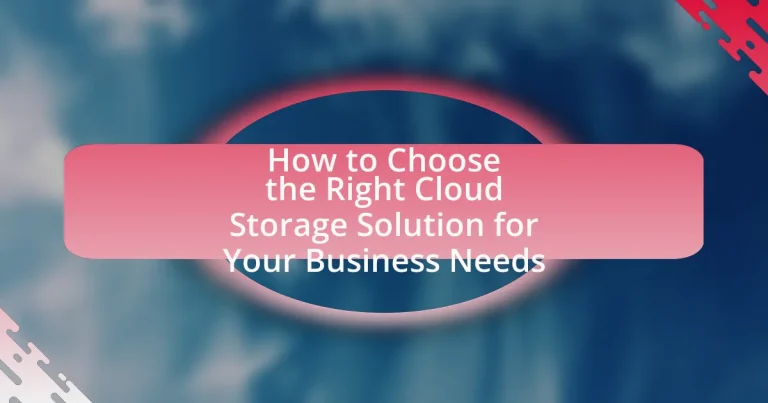The article focuses on selecting the appropriate cloud storage solution tailored to business needs. It outlines critical factors to consider, including security, scalability, cost, and ease of use, while emphasizing the importance of aligning storage capabilities with specific business requirements. The discussion covers various types of cloud storage, such as public, private, and hybrid options, and highlights the significance of evaluating costs, hidden fees, and compliance with industry standards. Additionally, best practices for implementation, data management, and ongoing optimization are provided to ensure effective use of cloud storage solutions.
What Factors Should You Consider When Choosing a Cloud Storage Solution for Your Business?
When choosing a cloud storage solution for your business, consider factors such as security, scalability, cost, and ease of use. Security is crucial; ensure the provider offers encryption and compliance with regulations like GDPR. Scalability allows your storage needs to grow with your business, preventing future limitations. Cost should be evaluated not just in terms of monthly fees but also potential hidden costs, such as data retrieval fees. Lastly, ease of use impacts team productivity; a user-friendly interface can facilitate quicker adoption and minimize training time.
How do your business needs influence your choice of cloud storage?
Business needs significantly influence the choice of cloud storage by determining factors such as storage capacity, security requirements, and compliance standards. For instance, a business that handles sensitive customer data may prioritize cloud storage solutions that offer advanced encryption and compliance with regulations like GDPR or HIPAA. Additionally, businesses with fluctuating data storage needs may opt for scalable solutions that allow for easy adjustments in storage capacity, ensuring cost-effectiveness and flexibility. According to a report by Gartner, 70% of organizations cite scalability as a key factor in their cloud storage decision-making process, highlighting the importance of aligning cloud storage capabilities with specific business requirements.
What specific storage requirements does your business have?
The specific storage requirements for a business typically include data capacity, security measures, accessibility, and compliance with regulations. For instance, a business may require a minimum of 1 TB of storage to accommodate its data needs, along with encryption protocols to ensure data security. Additionally, the ability to access data from multiple devices and locations is crucial for operational efficiency. Compliance with industry regulations, such as GDPR or HIPAA, may also dictate specific storage practices, ensuring that sensitive information is handled appropriately.
How does data security impact your cloud storage decision?
Data security significantly influences cloud storage decisions by determining the level of trust a business can place in a provider. Organizations prioritize cloud solutions that offer robust encryption, compliance with regulations such as GDPR and HIPAA, and reliable access controls to protect sensitive information. For instance, a study by the Ponemon Institute found that 60% of organizations consider data security as the most critical factor when selecting a cloud service provider. This focus on security ensures that businesses can mitigate risks associated with data breaches and maintain customer confidence.
What types of cloud storage solutions are available?
There are several types of cloud storage solutions available, including public cloud storage, private cloud storage, hybrid cloud storage, and multi-cloud storage. Public cloud storage is offered by third-party providers and is accessible over the internet, making it cost-effective and scalable. Private cloud storage is dedicated to a single organization, providing enhanced security and control over data. Hybrid cloud storage combines both public and private cloud elements, allowing businesses to optimize their resources based on specific needs. Multi-cloud storage involves using multiple cloud services from different providers to avoid vendor lock-in and enhance redundancy. Each type serves distinct business requirements, enabling organizations to choose the most suitable option for their operational needs.
What is the difference between public, private, and hybrid cloud storage?
Public cloud storage is a service offered by third-party providers over the internet, allowing multiple users to share resources and infrastructure. Private cloud storage, in contrast, is dedicated to a single organization, providing enhanced security and control over data. Hybrid cloud storage combines both public and private cloud environments, enabling data and applications to be shared between them for greater flexibility and scalability. This differentiation is crucial for businesses to assess their specific needs regarding security, cost, and resource management when selecting a cloud storage solution.
How do different cloud storage models affect scalability?
Different cloud storage models significantly affect scalability by determining how resources can be allocated and adjusted based on demand. For instance, public cloud storage offers virtually unlimited scalability, allowing businesses to easily increase storage capacity without upfront investments in hardware. In contrast, private cloud storage may limit scalability due to fixed resources and higher costs associated with infrastructure expansion. Hybrid cloud models provide a balance, enabling businesses to scale resources dynamically by leveraging both public and private cloud capabilities. This flexibility is crucial for businesses experiencing fluctuating workloads, as it allows them to optimize costs while meeting storage needs efficiently.
Why is it important to evaluate the cost of cloud storage solutions?
Evaluating the cost of cloud storage solutions is crucial for businesses to ensure they are making financially sound decisions. By analyzing costs, organizations can identify the most cost-effective options that align with their storage needs and budget constraints. For instance, a study by Gartner indicates that businesses can save up to 30% on storage costs by selecting the right cloud provider based on a thorough cost evaluation. This process helps in avoiding unexpected expenses and optimizing resource allocation, ultimately contributing to better financial management and operational efficiency.
What are the hidden costs associated with cloud storage?
Hidden costs associated with cloud storage include data transfer fees, storage overage charges, and costs related to data retrieval. Data transfer fees can arise when moving data in and out of the cloud, often leading to unexpected expenses, especially for businesses with high data traffic. Storage overage charges occur when the amount of data stored exceeds the allocated plan, resulting in additional monthly fees. Furthermore, costs for data retrieval can be significant, particularly if accessing archived data or if the service provider charges for data egress. According to a study by the Cloud Industry Forum, 30% of businesses reported unanticipated costs related to cloud services, highlighting the importance of understanding these hidden expenses when selecting a cloud storage solution.
How can you calculate the total cost of ownership for cloud storage?
To calculate the total cost of ownership (TCO) for cloud storage, sum all direct and indirect costs associated with the service over its expected lifespan. Direct costs include subscription fees, data transfer fees, and storage costs, while indirect costs encompass management time, training, and potential downtime impacts. For instance, if a business pays $100 per month for storage, incurs $50 monthly in data transfer fees, and allocates 10 hours monthly for management at a rate of $20 per hour, the TCO over one year would be $1,800 ($1,200 for storage, $600 for data transfer, and $2,400 for management). This comprehensive approach ensures that all financial implications are considered, providing a clearer picture of the overall investment in cloud storage.
How Can You Assess the Reliability of a Cloud Storage Provider?
To assess the reliability of a cloud storage provider, evaluate their uptime guarantees, data redundancy measures, and security protocols. Uptime guarantees indicate the provider’s commitment to service availability, with reputable providers typically offering at least 99.9% uptime. Data redundancy measures, such as multiple data center locations and regular backups, ensure data integrity and availability in case of hardware failures. Security protocols, including encryption standards and compliance with regulations like GDPR or HIPAA, demonstrate the provider’s commitment to protecting user data. These factors collectively provide a comprehensive view of a provider’s reliability.
What criteria should you use to evaluate cloud storage providers?
To evaluate cloud storage providers, consider criteria such as security, scalability, pricing, performance, and customer support. Security is crucial; providers should offer encryption, compliance with regulations like GDPR, and robust access controls. Scalability ensures that the storage solution can grow with your business needs, allowing for easy upgrades. Pricing should be transparent, with no hidden fees, and should align with your budget while providing value. Performance metrics, including uptime guarantees and data transfer speeds, are essential for ensuring reliable access to your data. Finally, customer support should be responsive and available through multiple channels, as effective assistance is vital for resolving issues quickly.
How important is uptime and availability in your selection process?
Uptime and availability are critical factors in the selection process for cloud storage solutions. High uptime ensures that data is accessible when needed, which is essential for business continuity and operational efficiency. According to a study by Gartner, organizations can lose up to $5,600 per minute during downtime, highlighting the financial impact of availability issues. Therefore, prioritizing solutions with robust uptime guarantees and proven reliability is essential for minimizing risks and ensuring seamless access to data.
What role do customer reviews and testimonials play in your assessment?
Customer reviews and testimonials are critical in assessing cloud storage solutions as they provide real-world insights into user experiences. These reviews often highlight the strengths and weaknesses of a service, enabling potential customers to make informed decisions based on the feedback of others who have utilized the service. For instance, a study by BrightLocal found that 91% of consumers read online reviews, and 84% trust them as much as personal recommendations. This data underscores the importance of customer feedback in shaping perceptions and guiding choices in cloud storage solutions.
How do compliance and certifications affect your choice of provider?
Compliance and certifications significantly influence the choice of a provider by ensuring that the provider meets industry standards and regulatory requirements. Providers with recognized certifications, such as ISO 27001 or SOC 2, demonstrate their commitment to data security and privacy, which is crucial for businesses handling sensitive information. For instance, a study by the Ponemon Institute found that organizations using certified providers experienced 50% fewer data breaches compared to those that did not prioritize compliance. This evidence underscores the importance of selecting providers that adhere to compliance frameworks, as it directly impacts the security posture and risk management of a business.
What industry standards should your cloud storage provider meet?
A cloud storage provider should meet industry standards such as ISO/IEC 27001 for information security management, SOC 2 compliance for data security and privacy, and GDPR for data protection in the European Union. These standards ensure that the provider implements robust security measures, maintains data integrity, and complies with legal requirements. For instance, ISO/IEC 27001 certification demonstrates a systematic approach to managing sensitive company information, while SOC 2 compliance indicates adherence to strict security and privacy controls. Compliance with GDPR is crucial for businesses operating in or with clients in the EU, as it mandates stringent data handling and protection practices.
How can you verify a provider’s compliance with data protection regulations?
To verify a provider’s compliance with data protection regulations, review their certifications and audit reports. Providers often obtain certifications such as ISO 27001 or adhere to frameworks like GDPR, which demonstrate their commitment to data protection standards. Additionally, request documentation of their data handling practices, including privacy policies and incident response plans, to ensure they align with regulatory requirements.
What Best Practices Should You Follow When Implementing Cloud Storage?
When implementing cloud storage, best practices include assessing your business needs, ensuring data security, and establishing a clear data management strategy. Assessing business needs involves evaluating storage requirements, access patterns, and compliance regulations to select the appropriate cloud solution. Ensuring data security requires implementing encryption, access controls, and regular security audits to protect sensitive information. Establishing a clear data management strategy includes organizing data effectively, setting retention policies, and planning for data backup and recovery. These practices are supported by industry standards, such as the Cloud Security Alliance’s guidelines, which emphasize the importance of security and compliance in cloud storage implementations.
How can you ensure a smooth transition to cloud storage?
To ensure a smooth transition to cloud storage, businesses should conduct a thorough assessment of their current data management practices and identify specific needs. This involves evaluating the volume of data, compliance requirements, and integration capabilities with existing systems. A study by Gartner indicates that 70% of organizations that fail to plan for cloud migration experience significant disruptions, highlighting the importance of a structured approach. Additionally, implementing a phased migration strategy allows for testing and adjustments, reducing the risk of data loss or downtime during the transition.
What steps should you take to migrate data to the cloud securely?
To migrate data to the cloud securely, first, conduct a thorough assessment of your data and compliance requirements. This involves identifying sensitive data, understanding regulatory obligations, and determining the necessary security measures. Next, implement strong encryption for data both in transit and at rest, ensuring that unauthorized access is prevented. Additionally, utilize secure transfer protocols, such as SFTP or HTTPS, to protect data during the migration process.
After that, establish access controls and authentication mechanisms to limit who can access the data in the cloud environment. Regularly monitor and audit the cloud environment for any security vulnerabilities or unauthorized access attempts. Finally, create a comprehensive backup strategy to ensure data recovery in case of any migration issues or data loss. These steps are essential for maintaining data integrity and security during the migration to the cloud.
How can you train your team to use the new cloud storage solution effectively?
To train your team to use the new cloud storage solution effectively, implement structured training sessions that cover the platform’s features, functionalities, and best practices. These sessions should include hands-on demonstrations, guided tutorials, and interactive Q&A segments to ensure comprehensive understanding. Research indicates that organizations that provide thorough training see a 30% increase in user adoption rates (Source: TechTarget, “The Importance of Cloud Training,” 2021). Additionally, creating user manuals and providing ongoing support can reinforce learning and address any challenges that arise during the transition.
What ongoing management practices are essential for cloud storage?
Ongoing management practices essential for cloud storage include regular monitoring, data backup, access control, and compliance management. Regular monitoring ensures performance optimization and identifies potential issues, while data backup protects against data loss, with best practices recommending daily backups. Access control involves managing user permissions to safeguard sensitive information, and compliance management ensures adherence to regulations such as GDPR or HIPAA, which is critical for maintaining data integrity and security. These practices collectively enhance the reliability and security of cloud storage solutions.
How can you monitor and optimize your cloud storage usage?
To monitor and optimize your cloud storage usage, utilize built-in analytics tools provided by your cloud service provider, such as AWS CloudWatch or Google Cloud Monitoring, which track storage consumption and performance metrics. These tools allow you to identify underutilized resources, enabling you to delete or downsize them, thus reducing costs. Additionally, implementing lifecycle policies can automate the transition of data to lower-cost storage classes based on access frequency, further optimizing expenses. According to a report by Gartner, organizations can save up to 30% on cloud storage costs by effectively managing and optimizing their storage usage.
What strategies can you implement for data backup and recovery in the cloud?
To implement effective data backup and recovery strategies in the cloud, utilize a multi-tiered approach that includes regular automated backups, data encryption, and geographic redundancy. Regular automated backups ensure that data is consistently saved at scheduled intervals, minimizing the risk of data loss. Data encryption protects sensitive information during transfer and storage, safeguarding it from unauthorized access. Geographic redundancy involves storing copies of data in multiple locations, which enhances recovery options in case of a regional outage or disaster. According to a study by the International Data Corporation, organizations that implement these strategies experience a 50% reduction in data loss incidents, demonstrating the effectiveness of a comprehensive cloud backup and recovery plan.
What tips can help you maximize the benefits of cloud storage for your business?
To maximize the benefits of cloud storage for your business, implement a structured data management strategy. This involves organizing files systematically, using clear naming conventions, and categorizing data to enhance retrieval efficiency. Additionally, regularly review and update your storage plan to align with evolving business needs, ensuring that you utilize the most relevant features offered by your cloud provider. According to a report by Gartner, effective data management can improve productivity by up to 30%, demonstrating the tangible benefits of a well-structured approach to cloud storage.


